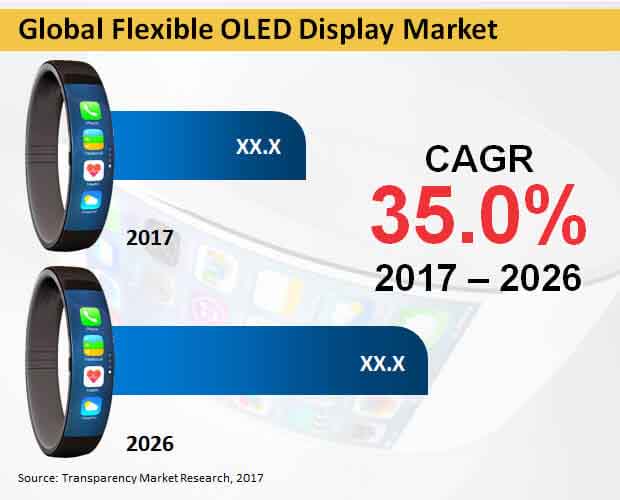
OLED or Organic Light Emitting Diode is one of the most advanced technologies that permits the display to be bent, rolled, and folded. An OLED display attains this sort of flexibility by including a flexible substrate below the organic one. OLED displays are preferred over their LCD counterparts as they have lower energy consumption as they operate without a backlight. The demand for flexible displays arises largely from the consumer electronics industry as flexible displays can be used to great effect in smartphones, televisions, wearables, and tablets. Transparency Market Research estimates that the global flexible OLED market should witness an exponential CAGR of 35% from 2017 to 2026.
AMOLED Segment Surges Ahead of PMOLED in Flexible OLED Display Market
The AMOLED segment dominates the flexible OLED display market and is expected to gain substantial share over the course of the forecast period. The AMOLED segment is poised to be worth slightly under US$ 3 billion by the end of 2026, making it an opportunity too large to ignore in the flexible OLED display market. The maximum share is contributed by the APEJ region and this is unlikely to change anytime soon. The PMOLED segment is considerably smaller in comparison. Nonetheless, it is unwise to ignore this segment entirely in favor of the AMOLED segment as PMOLED has a double-digit revenue share in the flexible OLED display market.

Request for a sample:
https://www.transparencymarketresearch.com/sample/sample.php?flag=S&rep_id=36602
Curved Displays More Popular than Foldable Displays in Flexible OLED Display Market
The curved display segment holds the lion’s share of the flexible OLED display market by flexibility type but is poised to lose massive share over the period of the study. However, curved displays are predicted to retain their leadership position in the flexible OLED display market. The curved display segment is projected to have a value of more than US$ 180 million in 2017 alone with APEJ comprising the bulk of the market. However, a larger CAGR is projected in the Japan curved display market and companies would do well to take this into account while devising their regional strategies.
Huge Demand in Lighting and Smartphone Segment for Flexible OLED Displays
In terms of application, the lighting and the smartphone segment have a similar revenue share in the flexible OLED display market with the former inching slightly ahead. The lighting segment could create an absolute dollar opportunity of approx. US$ 237 million from the year 2017 to 2026. Along with lighting, companies are recommended to target the smartphone segment with all guns blazing. The proliferation of smartphones as a result of plunging prices is fuelling adoption, particularly in the highly populous APEJ region. OLED displays are preferred over LCD as they offer an extremely high contrast ratio, sharper and clear images, and are more power-efficient in the long run. The APEJ smartphone segment of the flexible OLED display market is larger than that of North America and Europe combined.
Ask for brochure:
https://www.transparencymarketresearch.com/sample/sample.php?flag=B&rep_id=36602
Niche Potential in Television and Monitor Segment of Flexible OLED Display Market
The television and monitor segment have a marginal revenue share in the flexible OLED display market with the television segment assessed to grow faster. OLED displays are very expensive to mass-produce on a large scale and the television segment of the flexible OLED display market is on track to have a value of roughly half a billion dollars only by the end of 2026.
Competition Dashboard in the Flexible OLED Display Market
The companies profiled in the report are LG Display, AU Optronics, Samsung Display, CSOT, EverDisplay Optronics (EDO), Japan Display, Visionox, Universal Display, RiTdisplay, and BOE Technology.
Read Our Latest Press Release:





